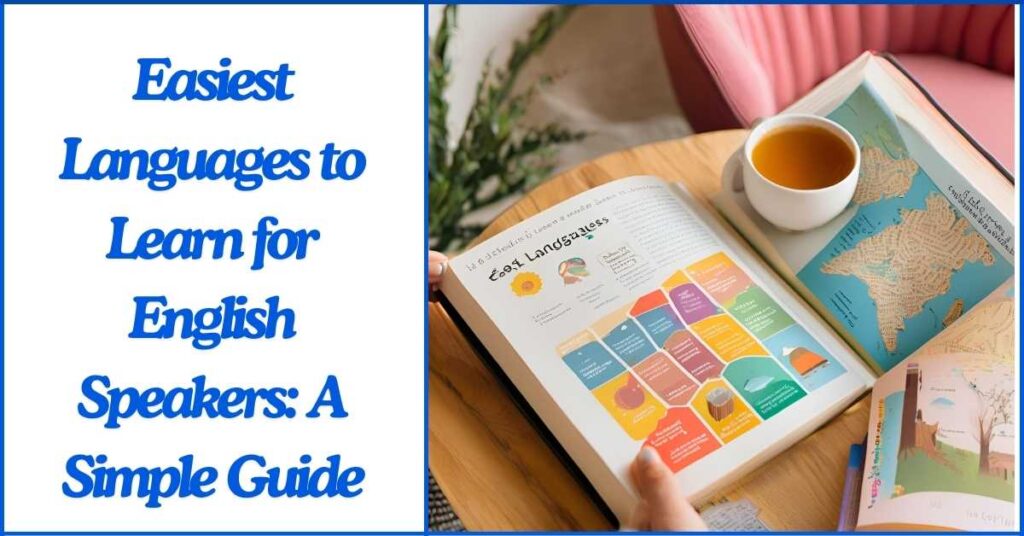Learning a new language can open up a world of opportunities. For English speakers, though, some languages are naturally easier to grasp than others. Whether you’re looking to travel, broaden your career prospects, or simply want to connect with more people around the globe, picking a language that’s relatively easy can make the process smoother. So, what are the easiest languages to learn for English speakers? Let’s dive into it.
Why Some Languages Are Easier to Learn for English Speakers
As an English speaker, certain languages come with a built-in advantage. English has roots in both Germanic and Romance languages, which makes it easier to pick up similar languages that share vocabulary, grammar structures, and pronunciation patterns. Additionally, languages that use the Latin alphabet or have straightforward grammar tend to be less of a struggle for native English speakers.
Approximate Learning Time for English Speakers:
| Language | Estimated Learning Time (Hours) | Approximate Time (Months) | Difficulty Level |
| Spanish | 600-750 | 6-8 months | Easy |
| French | 600-750 | 6-8 months | Easy |
| Italian | 600-750 | 6-8 months | Easy |
| Dutch | 600-750 | 6-8 months | Easy |
| Norwegian | 600-750 | 6-8 months | Easy |
| Portuguese | 600-750 | 6-8 months | Easy |
| Swedish | 600-750 | 6-8 months | Easy |
Key Factors Affecting Learning Time:
- Study Frequency: More frequent practice shortens the learning time.
- Immersion: Practicing with native speakers accelerates fluency.
- Motivation and Consistency: The more motivated and consistent you are, the quicker you’ll learn.
Now, let’s break down the top options that are most accessible.
1. Spanish
Without a doubt, Spanish is one of the easiest languages for English speakers to learn. As a Romance language, it shares many Latin-based words with English, so you’ll find plenty of familiar vocabulary.
Why it’s easy:
- Straightforward pronunciation: What you see is what you say.
- Relatively simple grammar.
- Spanish is widely spoken, so you’ll have many opportunities to practice.
Bonus tip: Spanish is everywhere, from the U.S. to Latin America to Spain, so it’s a practical choice that will give you many chances to use it in real-life situations.
2. French
French is another Romance language that shares a lot of vocabulary with English. In fact, English borrowed many words directly from French, so you’ll recognize many terms right away.
Why it’s easy:
- Similar sentence structure to English.
- Many English words come directly from French.
- Widespread resources for learning, from movies to apps to podcasts.
Bonus tip: While the pronunciation can be tricky at first, once you grasp the basics, it becomes second nature.
3. Italian
For those with a love for food, art, and culture, Italian is an appealing option. It’s very close to both Spanish and French, making it another great choice for English speakers.
Why it’s easy:
- Simple vowel sounds and clear pronunciation.
- Vocabulary similar to other Romance languages.
- Musical and rhythmic, making it fun to speak.
Bonus tip: Italian is spoken in many parts of Europe, and learning it can make traveling through Italy and beyond even more rewarding.
4. Dutch
Dutch is part of the Germanic family of languages, making it one of the easiest for native English speakers to pick up. In fact, many English words are almost identical to their Dutch counterparts.
Why it’s easy:
- Dutch uses the same alphabet as English.
- Many words are quite similar, like “water” (English) and “water” (Dutch).
- Straightforward grammar and sentence structure.
Bonus tip: If you’re planning to travel or work in the Netherlands or Belgium, learning Dutch will help you immensely in these countries.
5. Norwegian
Norwegian belongs to the Scandinavian group of languages and is surprisingly easy for English speakers due to its clear and logical structure.
Why it’s easy:
- Shares many cognates (similar words) with English.
- Simple and consistent pronunciation.
- Verb conjugation is much simpler than in English.
Bonus tip: Norway has high English proficiency, which can make learning Norwegian less intimidating because people will often switch to English if you’re struggling.
6. Portuguese
Similar to Spanish, Portuguese is another Romance language that is relatively easy for English speakers. It’s spoken widely in both Portugal and Brazil, offering a fantastic cultural experience alongside language learning.
Why it’s easy:
- Many familiar vocabulary words due to its Latin roots.
- Shares a lot with Spanish, so if you know one, the other comes more easily.
- Clear sentence structure.
Bonus tip: If you’re interested in Brazilian culture, learning Portuguese can deepen your appreciation for its music, food, and traditions.
7. Swedish
Another Scandinavian language that ranks as easy is Swedish. If you’ve already mastered English and want to try something new, Swedish is a good option that won’t overwhelm you.
Why it’s easy:
- Similar sentence structure to English.
- Straightforward grammar with no complicated verb tenses.
- Many words are surprisingly similar, like “film” in English and “film” in Swedish.
Bonus tip: Swedish shares similarities with other Scandinavian languages, so learning it can make languages like Danish and Norwegian more accessible.
Quick Comparison Table:
| Language | Key Benefits |
| Spanish | Widely spoken, simple grammar |
| French | Shared vocabulary, cultural influence |
| Italian | Clear pronunciation, musical |
| Dutch | Similar words, simple grammar |
| Norwegian | Consistent rules, close to English |
| Portuguese | Similar to Spanish, useful in Brazil |
| Swedish | Simple grammar, useful in Scandinavia |
FAQs:
Absolutely! But it’s best to start with one and build a solid foundation before diving into another, especially if the languages are similar, like Spanish and Portuguese.
It varies, but with consistent effort, you can reach conversational fluency in 6-12 months for most of these languages.
Both are great options! Formal classes offer structure, while self-study gives you flexibility. Ideally, combining both will give you the best results.
Final Thoughts
Choosing the right langufage to learn doesn’t have to be daunting. By selecting one that closely aligns with English, you can make the process smoother and more enjoyable. Whether you’re drawn to the melodic tones of Italian or the practicality of Spanish, you’re already one step ahead as an English speaker. So, pick the language that excites you most, and get started! The journey of learning a new language is incredibly rewarding, and before you know it, you’ll be speaking with confidence.






